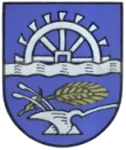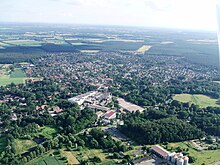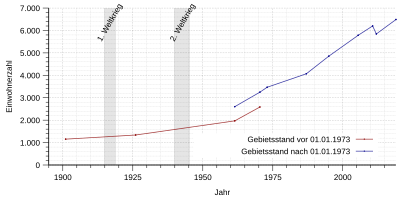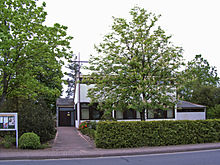Lachendorf
| coat of arms | Germany map | |
|---|---|---|

|
Coordinates: 52 ° 37 ' N , 10 ° 15' E |
|
| Basic data | ||
| State : | Lower Saxony | |
| County : | Celle | |
| Joint municipality : | Lachendorf | |
| Height : | 49 m above sea level NHN | |
| Area : | 38.24 km 2 | |
| Residents: | 6471 (Dec. 31, 2019) | |
| Population density : | 169 inhabitants per km 2 | |
| Postal code : | 29331 | |
| Area code : | 05145 | |
| License plate : | CE | |
| Community key : | 03 3 51 016 | |
| LOCODE : | DE 75Y | |
| Community structure: | 4 districts | |
| Address of the municipal administration: |
Oppershäuser Str. 1 29331 Lachendorf |
|
| Website : | ||
| Mayor : | Hartmut Ostermann ( CDU ) | |
| Location of the municipality of Lachendorf in the district of Celle | ||
Lachendorf is a municipality in the district of Celle in Lower Saxony .
geography
Geographical location
The community is located on the southern edge of the Lüneburg Heath (southeast of Celle ). Lachendorf is the seat of the Lachendorf joint community with the political communities of Ahnsbeck , Beedenbostel , Eldingen , Hohne and Lachendorf itself.
With the law on the reorganization of the communities in the district of Celle of January 1, 1972, the Lachendorf area was finally arranged. In terms of area, the Lachendorf municipality is in third place in the district with 164.51 km² .
Lachendorf is located at the outlet of the Lachte river from the gently undulating southern heath into the wide and flat glacial valley of the Aller . Due to its elevated position, it has been spared from floods in the past.
Community structure
The first communal amalgamations took place in 1968 as part of the administrative reform in Lower Saxony .
The municipality of Lachendorf consists of the following four districts:
- Bunkenburg
- Gockenholz
- Jarnsen
- Lachendorf
history
Early days
Finds from the Stone and Bronze Ages, primarily in the Lachte dunes, indicate that the Lachendorfer area was used by humans long before our era.
middle Ages
The current place name Lachendorf is also listed in old scripts as Lachtendorp or Lachendorp . Old names of the place are around 1196-1197 Locthendorp, 1278 Lachtendorpe, 1278 Lachtendorpe and in 1301 Lochtendorp. Lachendorf probably means "The village on the Lachte" and is given by its location on the river. “Laughing” is a very old, probably pre-Germanic formation for a word for “pond, lake, water point, swamp water”.
The oldest written mention of Lachendorf comes from the year 1353 and is contained in a list by Duke Wilhelm II (Braunschweig-Lüneburg) . The treasury register of the Grand Bailiff of Celle from 1438 names 18 farms in Lachendorf, including a mill.
Modern times
In 1538, Duke Ernst the Confessor selected Lachendorf as the location for a paper mill - the basis for the settlement of new residents was thus given, and the place was from now on decisively shaped by this pre-industrial manufacture. The Walsroder paper mill and the Bommels paper mill in Bomlitz were also founded under the Pfuhl papermaking dynasty .
In 1845 the expansion of the paper mill into a paper mill began. The expanding company moved more workers to Lachendorf, so that the population rose from 445 in 1848 to 1911 in 1900. A siding to the paper mill was laid from the small railway line Celle-Wittingen , which opened in 1904 .
present
Lachendorf belonged to the administrative district of Lüneburg until December 31, 2004 , which was dissolved as a result of an administrative reform at the end of this date.
Incorporations
On January 1, 1973 the communities of Bunkenburg, Gockenholz and Jarnsen were incorporated.
Population development
- December 31, 1900: 1,152 inhabitants
- December 31, 1925: 1,338 inhabitants
- 06.06.1961: 1,969 inhabitants
(with the later incorporated towns 2,602 inhabitants) - May 27, 1970: 2,586 inhabitants
(with the later incorporated towns 3,249 inhabitants) - 01/01/1973: 3,467 inhabitants
- December 31, 1986: 4,069 inhabitants
- December 31, 1994: 4,852 inhabitants
- June 30, 2005: 5,785 inhabitants
- August 31, 2010: 6,201 inhabitants
- December 31, 2011: 5,844 inhabitants
- December 31, 2018: 6,490 inhabitants
Religions
In Lachendorf in Brömmerkamp is the Noah's Ark of the Evangelical Lutheran parish of Lachendorf, which is part of the Celle parish.
As well as the church of the Christ Community in Kirchstrasse, which belongs to the parish of Celle-Lachendorf of the Independent Evangelical Lutheran Church ( SELK ).
The Catholic church house St. Raphael was built in 1968 on Heidkamp, since 2006 it has belonged to the parish of St. Ludwig in Celle. Before that, a chapel car set up in Lachendorf had served as a Catholic chapel for the Eastern Priest Aid from around 1954 .
The New Apostolic Church , Westerfeld 16, was closed. It belonged to the church district Hanover North . The building was sold and is now used for residential purposes.
politics
Municipal council
The council of the municipality of Lachendorf consists of 17 members.
| CDU | SPD | UB | FDP | Green | total | |
| 2001 | 6th | 6th | 3 | 1 | 1 | 17 seats |
| 2006 | 6th | 7th | 2 | 2 | 0 | 17 seats |
| 2011 | 5 | 7th | 3 | 2 | 0 | 17 seats |
last local election on September 11, 2011
A counting community consists of the SPD and FDP in the municipal council .
mayor
Hartmut Ostermann is currently the mayor of Lachendorf.
Town twinning
Lachendorf is twinned with the city of Bricquebec ( Normandy , France ).
coat of arms
The coat of arms of the political community Lachendorf is identical to that of the integrated community Lachendorf. It was approved in 1968. It shows a mill wheel on a blue background, a silver wavy bar and, underneath, a golden ear of wheat over a silver plow.
Culture and sights
Architectural monuments
Economy and Infrastructure
traffic
The municipality of Lachendorf is located on Landesstraße 282 (L 282) between Celle and Wittingen . Occasionally, Heide-Bahn trains still run on the route of the former Lachtalbahn (operated by the OHE ) through the community.
Companies
The paper manufacturer Drewsen Spezialpapiere produces specialty papers at the Lachendorf site.
TrickWILK GmbH in Lachendorf, founded in 2002, specializes in the creation of DCP (Digital Cinema Packages), 35 mm and 16 mm film recording (Fazen) and the restoration of films. Another branch of trickWILK GmbH is located in Berlin.
The baker Jochen Gaues , known in the media as a “celebrity baker” and a supplier of upscale restaurants, has his bakery in Lachendorf.
media
In Lachendorf, the monthly bulletin of the joint community of Lachendorf is published and distributed free of charge to all households in the joint community.
education
schools
In Lachendorf there is the Ikarus Elementary School and the Oberschule Lachendorf, which arose from the amalgamation of the Geschwister-Scholl School (secondary school) and the Realschule Lachendorf, as well as the Gymnasium Lachendorf, which was completed in summer 2006 and is now called Immanuel-Kant-Gymnasium.
The secondary school Lachendorf had its origin in the district middle school Westercelle. After the building in Westercelle had become too small due to the increased number of students, the construction of a new two-class middle school was approved in 1964. Altenhagen was chosen as the location to shorten the way to school for schoolchildren from the northern districts.
Due to the school policy objectives of the State of Lower Saxony and as a result of the regional reform, the district of Celle, as the school authority, decided in 1976 to build a new secondary school in Lachendorf. The foundation stone was laid in Lachendorf on October 28, 1977, and in January 1979 classes began at the Lachendorf secondary school.
Sports
The oldest club in Lachendorf is the Schützenverein Lachendorf von 1881 eV. The Schützenhaus, which was completed in 1996, is the venue for numerous sporting competitions. The Lachendorfer Schützen think of several regional and district champions in their ranks.
Since the football club FC Lachendorf was founded in 1985, two clubs that host football have coexisted in the village. The club with the largest number of members, TuS Lachendorf , looks after several branches and was founded in 1926. In addition, the Lachendorf tennis club was launched in 1981 . The volleyball club of TuS Lachendorf has also been successful across the region.
Sports facilities
There are three sports halls in Lachendorf, whereby these must be assigned to the primary and secondary school as well as the grammar school. The Lachtestadion, the completion of which was completed in 1981, is the largest sports facility in the municipality of Lachendorf. There is also a tennis facility with six outdoor and three indoor courts.
In the immediate vicinity is the Schützenhaus, which was built in 1996 and has since been known as a location for shooting competitions even beyond the boundaries of the municipality.
The “Berliner Heide” glider airfield is located on the northeastern edge of the municipality in Metzingen .
Personalities
Sons and daughters of the church
- Wilhelm Trumann, great-great-grandfather of the 33rd President of the USA, Harry S. Truman
- Heinrich Severloh (1923–2006), Wehrmacht soldier and machine gunner on Omaha Beach
- Konstantin Rausch (* 1990), soccer player in the service of Dynamo Moscow
literature
- Martin Wittmann, Kurt W. Seebo: Lachendorf . Vol. I, Lachendorf 1988.
Web links
Individual evidence
- ↑ State Office for Statistics Lower Saxony, LSN-Online regional database, Table 12411: Update of the population, as of December 31, 2019 ( help ).
- ^ Jürgen Udolph (research): The "place name researcher". In: website NDR 1 Lower Saxony . Archived from the original on January 30, 2017 ; accessed on August 5, 2019 .
- ↑ Mußmann, Olaf: Paper, Powder and Soft Energy - Everyday Life and Technology in the Pre-Industrial Milling Industry, Münster 1993, p. 25 ff.
- ↑ In detail: Blazek, Matthias: Von der Landdrostey zur Bezirksregierung - The history of the Hanover district government as reflected in the administrative reforms, Stuttgart 2004, ISBN 3-89821-357-9 .
- ↑ a b c Federal Statistical Office (ed.): Historical municipality directory for the Federal Republic of Germany. Name, border and key number changes in municipalities, counties and administrative districts from May 27, 1970 to December 31, 1982 . W. Kohlhammer, Stuttgart / Mainz 1983, ISBN 3-17-003263-1 , p. 223 .
- ↑ KirchenZeitung No. 26/2013 of June 30, 2013, p. 16.
- ↑ Preliminary results of the district and municipal elections as a PDF document 2.90 MB ( Memento of the original from January 11, 2016 in the Internet Archive ) Info: The archive link was inserted automatically and has not yet been checked. Please check the original and archive link according to the instructions and then remove this notice.
- ↑ Office hours of the mayor
- ↑ Landesstraße L 282 (Wittinger Straße) forms an east-west axis between the central centers of Celle and Wittingen. It leads to the east-northeast via Beedenbostel , Eldingen and Steinhorst and behind Wittingen on to Helmstedt .
- ↑ Internet presence of the Oberschule Lachendorf .
- ↑ Internet presence of the Lachendorf grammar school .
- ↑ See germanoriginality.com .








